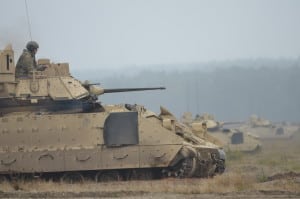Lockheed Martin [LMT] said Monday it has received a potential $30 million deal to begin integration of Modular Active Protection System (MAPS) base kits on Army combat vehicles, with deliveries set for 2023.
The contract could cover integration of the MAPS base kit on up to 20 vehicles over the next 36 months, as the Army continues to assess its plan for rolling out the capability designed to seamlessly integrate soft and hard-kill active countermeasures and components into a layered protection system.

“Lockheed Martin partnered with the U.S. Army in 2014 to develop MAPS as a safe and secure vehicle defense system that protects warfighters from a variety of anti-armor threats,” David Rohall, the company’s program manager for Advanced Ground Vehicle Systems, said in a statement. “Since then, the MAPS base kit has proven itself in multiple live-fire demonstrations. We’re ready to support integration and testing on a variety of Army combat vehicles, the final step before the Army makes a formal decision on fielding this capability.”
Rohall told Defense Daily the Army awarded Lockheed Martin an initial $1.5 million Other Transaction Authority agreement in December, followed by $3 million more in incremental funding, to cover an initial order for five MAPS base kits.
Additional MAPS base kits could be funded incrementally over the 36-month work period, according to Rohall, who noted the Army has not yet finalized its testing schedule.
Lockheed Martin’s work, which will start later this year and run through 2023, will include development of MAPS base kit hardware and software, platform integration and on-vehicle live-fire demonstrations.
The MAPS base kit could be integrated and tested on Abrams, AMPVs, Bradleys or Stykers and includes “an open-architecture processor that integrates vehicle sensors and countermeasures in a common framework to detect, track and defeat rocket-propelled grenades and anti-tank guided missiles,” according to Lockheed Martin.